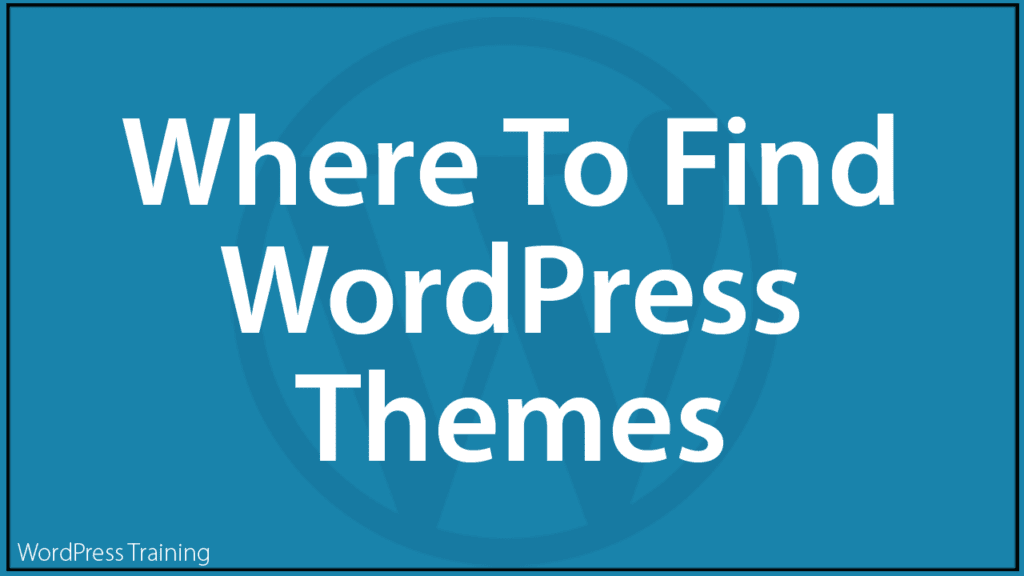Where To Find The Best WordPress Themes
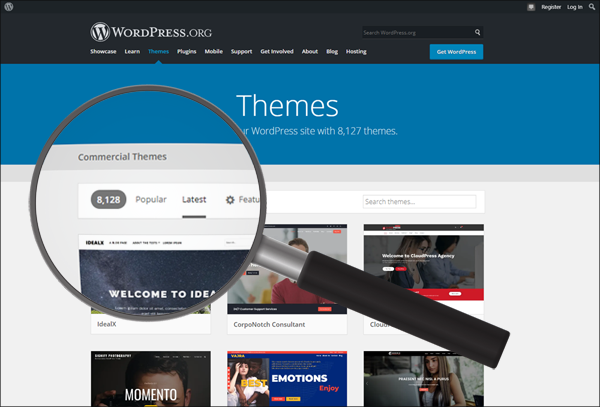 In this tutorial, you will learn:
In this tutorial, you will learn:
- WordPress theme licensing – what you need to know.
- Where to find free and paid themes for your WordPress site.
- Different types of WordPress theme resources,
- How to get the right theme for your business,
- How to avoid problems like lack of customer support and poorly-coded themes.
For additional information, see this tutorial: Using WordPress Themes
***
So Many WordPress Themes…Where To Begin?
As explained in this tutorial, themes are a unique type of web design template for WordPress-powered sites.
There are thousands of high-quality WordPress themes available, designed to suit all types of purposes, from personal blogs to professional services, corporate websites, portfolio sites, eCommerce sites, and so on.

Search on Google for the following phrases and you will come across many sites offering WordPress themes and WordPress theme reviews:
- Best free WordPress themes for WordPress
- WordPress themes free
- WordPress themes premium
- Best themes for WordPress
- Free WordPress theme [insert keyword here] (e.g. business, artist, musician, writer, church, author, portfolio, photography, etc.)
The sections below will help you save time finding and choosing the right WordPress theme for your needs.
WordPress Theme Licensing – What You Need To Know
The WordPress software is released under the GPLv2 (or later) GNU General Public License from the Free Software Foundation.
The GPL license gives you four core freedoms with the WordPress software.
You are free to:
- Run the program for any purpose.
- Study how the program works and change it to make it do what you wish.
- Redistribute it.
- Distribute copies of your modified versions to others.
Although the above freedoms affect mostly WordPress theme and plugin developers, as a WordPress user, it means that you are free to modify and customize any aspect of WordPress to suit your needs.
Under the terms of this license, derivatives of WordPress code like themes and plugins also inherit the GPL license.
This, however, is subject to ongoing discussions and debates in the WordPress community.
WordPress itself believes that plugins and themes are derivative work and should thus inherit the GPL license. However, as this is a gray area, some WordPress theme developers will release their themes (and plugins) using a “split-license,” where the theme’s PHP code is GPL-licensed, and other code elements like CSS, JS, and media included in the theme or plugin isn’t.
In simple terms, this means that some third-party theme (and plugin) developers may apply restrictive copyrights to certain elements of their themes or plugins if they wish, making them harder to customize or modify.
Keep this in mind when you search for new themes (or plugins).
Most free and premium (paid) themes for WordPress are distributed as open-source software under GPL terms, whereas some may be sold as proprietary software or with proprietary elements.
WordPress.com vs WordPress.org Themes
WordPress offers users a hosted and a self-hosted version.
With the hosted version (WordPress.com), you cannot upload and install a custom theme on your site unless you are on their Business plan or higher.
For this reason, we’ll focus on finding free and paid themes for the self-hosted version of WordPress (i.e. WordPress.org) in this tutorial, as these provide you with more freedom, more options, and more control over your site’s design while giving you the freedom to choose your own hosting set up from the start.
Free vs Paid Themes
There are thousands of Free and Paid themes available for WordPress users.
These can be found mostly in two types of places:
- WordPress theme marketplaces and directories.
- Commercial and independent WordPress theme developers and design companies.
WordPress theme marketplaces and directories are large theme store aggregators.
WordPress theme developers (both commercial and independent) list their themes (both free and paid) and users can search for themes just like they would if they were shopping for apps on an app store or software directory.
Some of the larger marketplaces don’t just sell WordPress themes. They also sell WordPress plugins and templates for other web applications (e.g. Joomla, Drupal, etc.)
Commercial and independent WordPress theme design companies can also develop free and paid themes, but their focus is typically on developing and supporting their own themes.
Theme developers can vary in size, from an individual, freelance, or small theme development team, to a large digital agency.
Many commercial or independent theme developers will sell their themes exclusively on their own web sites, but some will also list their themes in marketplaces and directories, or even create a free or “lite” version of their themes to add to the free WordPress theme directory (more info below).
Let’s show you where to find the best WordPress themes for your website or blog.
Free WordPress Themes
WordPress.org
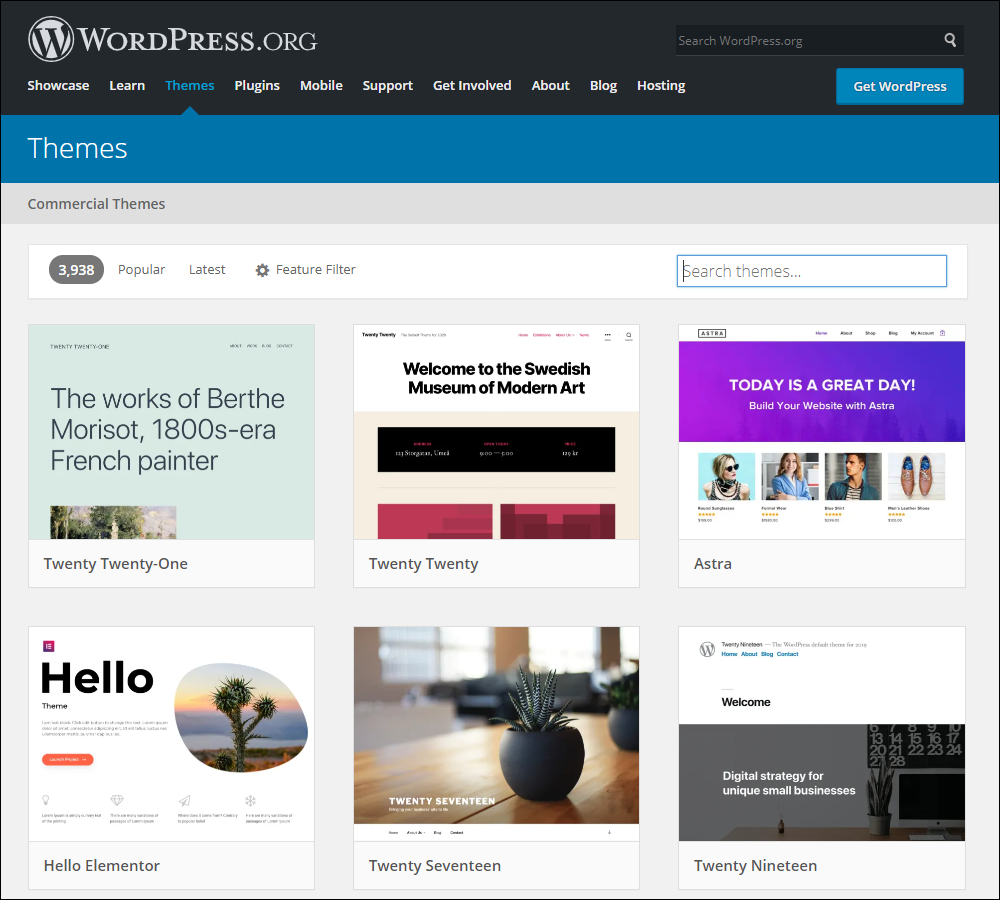
The official WordPress theme directory is the largest and the best place to find free WordPress themes for your site.
In fact, it’s probably the only free directory we recommend using to find and download free themes for WordPress.
As many free software users have learned the hard and painful way, free software, add-ons, apps, templates, or themes downloaded from untrustworthy places can contain malicious code and place your computer, website, or even your entire business at risk.
The WordPress.org theme directory is the most trustworthy and reputable place to download free themes for your site, as all themes uploaded to it have to comply with GPL licensing requirements and are reviewed by a team of dedicated and code-savvy members of the WordPress community to make sure they comply with the directory’s standards of quality and security.

To browse thousands of professionally designed free WordPress themes, visit the free WordPress theme directory.
![]()
You don’t even have to leave your site to find free themes. You can do it right from your WordPress dashboard by going to Appearance > Themes and clicking on the ‘Add New’ button to bring up the Add Themes screen.

From the Add Themes screen, you can easily:
- Browse all themes in the WordPress theme directory, including all featured, popular, and latest themes. Note: you will need to set up a free account at WordPress.org to view themes marked as Favorites (see further below).
- Find themes quickly using the search function (enter a keyword, e.g. ecommerce, portfolio, photography, etc.)
- Upload new themes to your site (e.g. premium themes).
- Install and activate themes with a few clicks.

Using The WordPress Feature Filter
Your WordPress site has a built-in filtering function in the Add Themes screen that lets you narrow down your search for themes based on criteria like colors, layout, and features.

This makes it easier to find themes with specific features.
For example, you could search for themes with a predominantly blue, orange, or light color design, a two or three-column layout, full-width templates, wide blocks, themes that support custom menus, etc.
Simply tick the checkboxes to select the features you’d like in your theme, then click the Apply Filters button to narrow your search to themes that include your selected features.
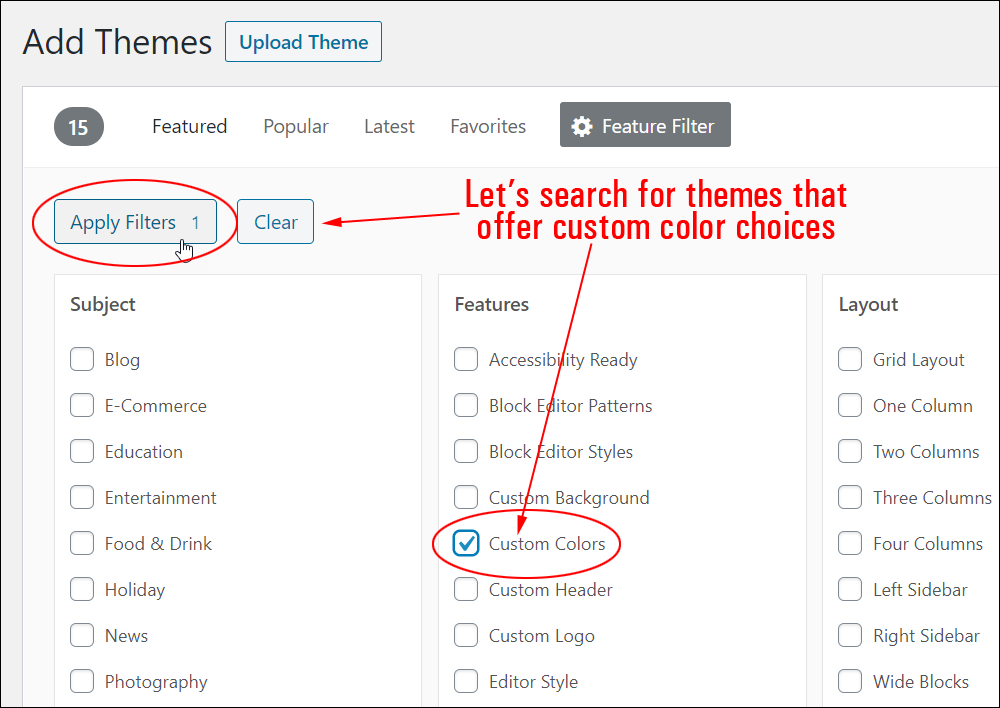
WordPress will then search across its entire database of free themes and return a list of themes that include your selected features.

Continue editing filters to narrow your search selection until you find a suitable theme.
Note: As WordPress themes continue to evolve and new features become standard, expect these to be removed from the Feature Filter.
For example, all modern WordPress themes are now responsive (i.e. they will automatically resize to fit the browsers and devices of users), so ‘responsive layout’ is no longer a searchable feature, as it is standard.

Pros & Cons Of Using Free WordPress Themes
The obvious benefit to using free themes is that it costs you nothing to download and use the theme on your site. Additionally, many free themes are professionally designed and come with a range of customizable options and settings, giving you great flexibility and choice in how you configure its design and layout elements.
The downside of using free WordPress themes is that your themes may not get updated as frequently as paid themes or include requested new features and bug fixes. It’s unrealistic to expect theme developers to provide dedicated theme support if they are not getting paid. Many free themes ask users for donations to help cover support costs.
When downloading free themes, it’s a good idea to check the following:
- When was the theme last updated? If it’s been many months since any updates were made, then it’s probably best to think about choosing another theme, as the theme may no longer be supported by its developer.
- Is it compatible with the latest version of WordPress? WordPress is continually updating its software, and this can result in conflicts and issues with code in older themes. Make sure to keep your site, your theme(s), and your plugins updated.
- Does it get favorable user reviews? Read comments and reviews from users. Avoid using themes with lots of poor ratings.
- What kind of support issues are users experiencing? Visit the theme’s support page to see what kind of issues users are raising with the theme developer. This will also give you an indication of how quickly and effectively developers respond when issues arise.
- Is the theme being downloaded often and regularly? The more recent downloads a theme has, the greater the chance that it will be regularly supported by the developer.
You can check the above information by hovering over the thumbnail of the theme you are interested in and clicking on the ‘More Info’ button.
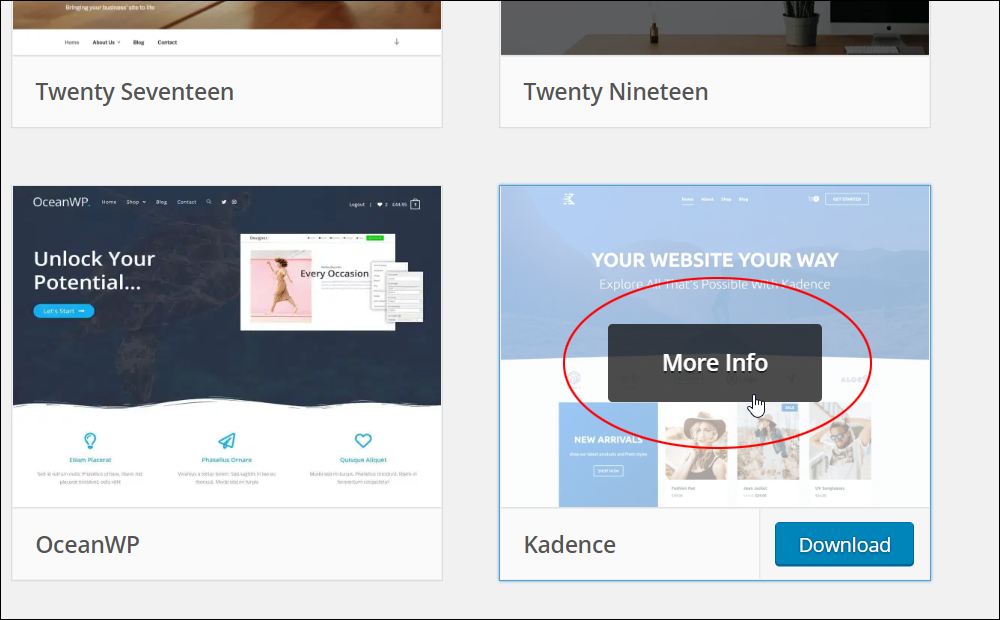
This will bring up the theme’s information page.

![]()
If you’re logged in as a user at WordPress.org (you can set up a free user account), you can also favorite the theme.
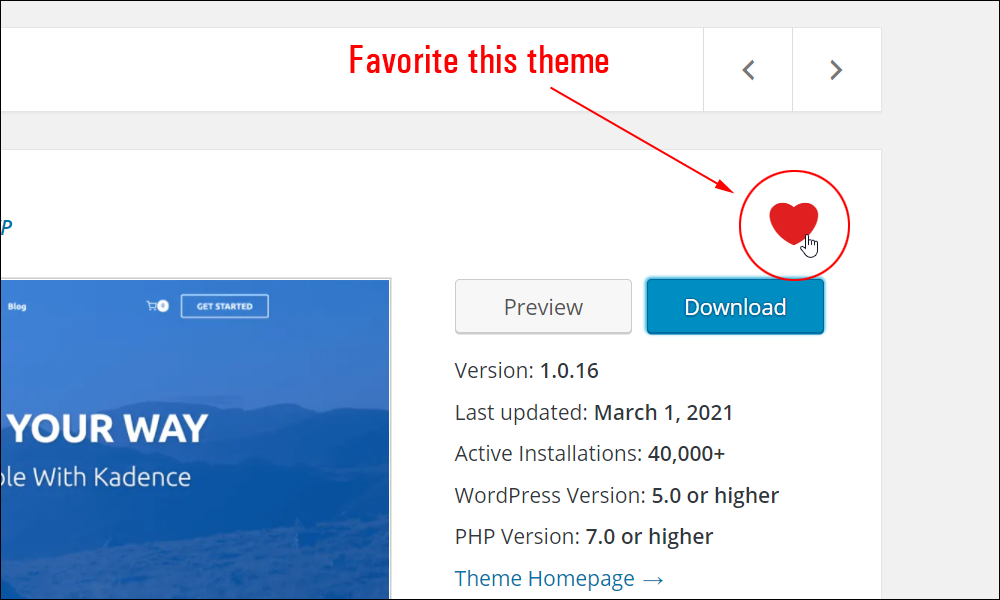
This lets you bookmark it, so you can come back and find it later (e.g. by going into the ‘Add Themes’ screen and clicking on the Favorites tab).
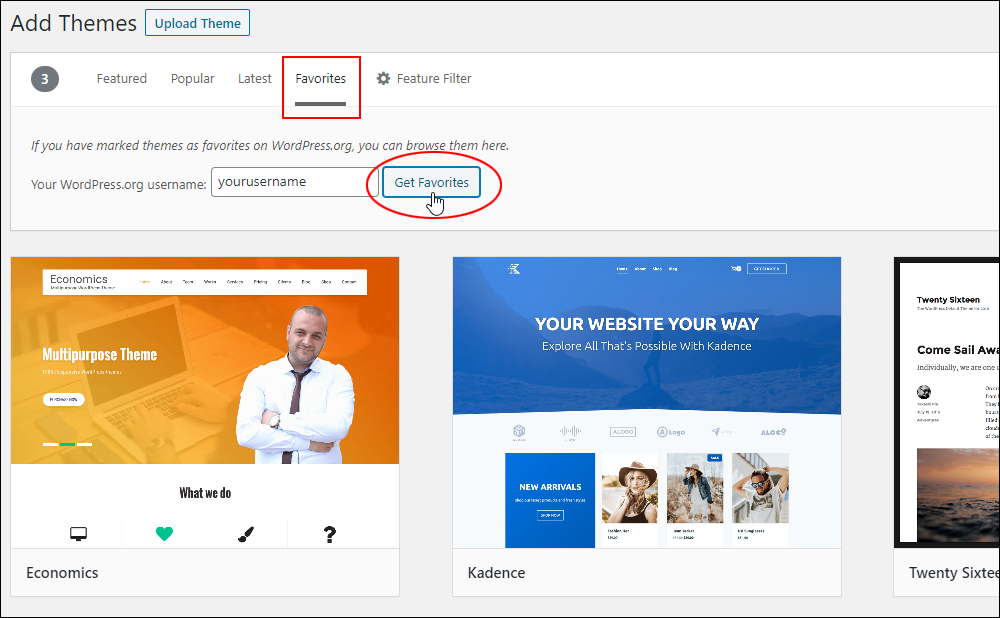
If you’re just getting started on a budget and your site is still relatively new, there is nothing wrong with using a free WordPress theme until you have a better idea of the type of design you would like for your site.
As WordPress themes are completely interchangeable, you can use a free theme to get your site up and running quickly and inexpensively. Who knows, the free theme may be all you need to grow your site.
Once you start getting traffic to your site and have a better idea of what kind of design, layout, and features would work best for your audience, you can then consider upgrading to a premium theme or even investing in custom web design.
Now that we’ve looked at how to find and narrow down your search for free themes, let’s turn our attention to finding premium (paid) themes for your WordPress site.
Premium (Paid) WordPress Themes
Many Premium themes offer stunning design and a wide range of customization options, allowing you to create a unique or distinctive look for your website.
Premium themes from reputable and trustworthy design companies are built by professional developers and provide WordPress users with high-quality web design at an affordable price, plus excellent support.
If you are looking for a premium theme for your site, here are some places to help you get started.
WordPress Theme Marketplaces And Directories
ThemeForest

ThemeForest is the largest and most popular WordPress theme marketplace.
ThemeForest allows many professional WordPress theme developers to showcase their designs. There are thousands of premium WordPress themes to choose from, and most themes can be purchased for well under US$100.

ThemeForest’s WordPress theme directory is divided into many categories, including bestsellers, discount/bargain themes, and areas such as:
- Blog/Magazine – themes for personal blogs, e-magazines, activism blogs, environmental blogs, parenting blogs, green living blogs}, etc.
- Corporate – themes suitable for business, corporate, government, legal, and medical sites, plus design and marketing agencies.
- Creative – themes for creative work, photography, design, portfolios, video galleries, writers, authors, art galleries, cv and resume writing, etc.
- Directory Listings – themes for job listings, employment directories, business, travel, and tourism directories, restaurants and dining, holiday rentals, classifieds, buy & sell, social directories, community resources, etc.
- eCommerce – themes for eCommerce, selling digital downloads, event bookings and registrations, membership sites, etc.
- Education – themes for sites related to teaching, training, tutoring, learning management systems, etc.
- Entertainment – themes for entertainment, celebrity news, fashion, film & tv, music, music venues, and bands, photo gallery blogs, dining out, cafes, nightclubs, etc.
- Mobile – mobile-switching, responsive, and retina-ready themes.
- NonProfit – themes for nonprofit organizations, charities, churches, etc.
- Real Estate – themes for real estate and real estate listings, home sales, rentals, commercial property, etc.
- Retail – themes for retail stores and shopping, health and beauty products, boutiques, catalogs, specialty stores, trades or professional services (plumbers, electricians, repairers, dental and medical practitioners, chiropractors, legal firms, etc.
- Technology – themes related to apps, software, hosting, technology, affiliate marketing, SEO, product reviews, direct sales, newsletters, lead gen landing pages, etc.
- Wedding – e.g. themes for wedding sites, marriage counseling, marriage celebrants, dating advice, etc.
- Miscellaneous – themes suitable for topics related to activism, political, or environmental issues, parenting, green living… even themes you can use if your site is still under construction!
When you purchase a WordPress theme from ThemeForest, you will receive email notifications whenever a new update is available for your theme.
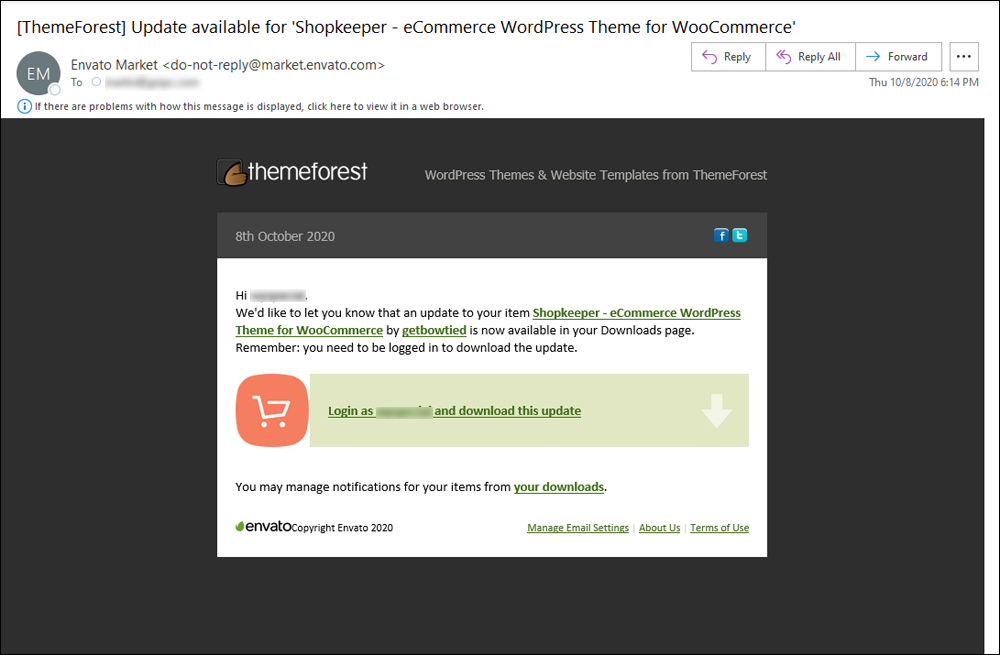
To browse thousands of quality premium WordPress themes in the ThemeForest marketplace, go here: ThemeForest
Creative Market
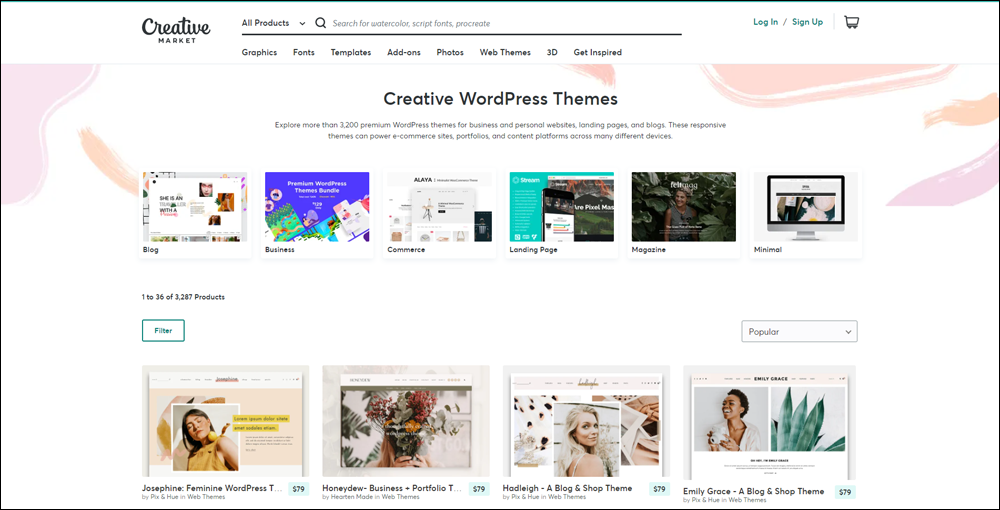
Creative Market is another leading WordPress theme marketplace where you can search through thousands of quality premium WordPress themes from independent theme creators.
As stated on their website …
“Creative Market is a platform for handcrafted, mousemade design content from independent creatives around the world.”
Creative Market doesn’t sell WordPress themes only in its marketplace, but you can easily browse through all of their WordPress themes and narrow your search using theme categories using the “Web Themes” menu.
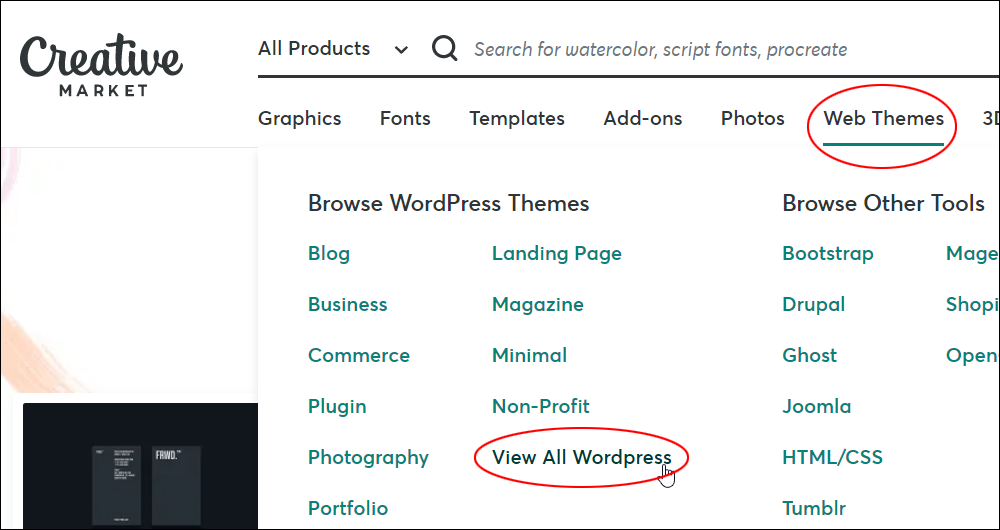
Browse hundreds of quality premium WordPress themes crafted by independent theme developers in the Creative Market theme directory here: Creative Market
Mojo Themes

Mojo is a marketplace for premium-quality WordPress themes where theme vendors are strongly encouraged to provide customers with lifetime support and upgrades.
According to their website …
“Mojo is a marketplace where anyone can find, rate and buy quality themes & templates in one trusted place.”
Like Envato and Creative Market, Mojo doesn’t focus exclusively on WordPress themes, but you can easily find WordPress themes and narrow your search with theme categories using the site’s “WordPress Themes” menu.

Visit the site to find quality premium WordPress themes here: Mojo Themes
Now that we have looked at some of the main WordPress theme marketplaces and theme aggregators, let’s turn our attention to commercial and independent WordPress theme development agencies.
Commercial And Independent WordPress Theme Designers
SoloStream

SoloStream provides WordPress users with a selection of quality WordPress themes and the option of accessing all themes through a WordPress theme membership.
StoreFront

StoreFront specializes in creating beautiful e-commerce themes for WordPress. Their themes integrate with some of the most powerful e-commerce platforms and plugins available.
StudioPress

StudioPress develops WordPress themes based on the “Genesis” framework, which allows you to build a professional and search-optimized WordPress website quickly and easily using a self-updating design architecture, turn-key designs with beautiful frames for your content, and unprecedented control of the framework.
Many website developers prefer using the Genesis framework because it’s well-coded, well-supported, you can update your themes without losing any customizations you have made, and the developers keep the framework regularly up to date to reflect best coding practices and to ensure that themes are always compatible with the latest version of WordPress.
StudioPress themes built with the Genesis framework use “child themes” to give your site its unique look and feel and are easy to work with, just like all other WordPress themes.
With StudioPress, you pay one low price to receive unlimited support and updates and you can install your themes on unlimited domains.
For more details, click here: StudioPress
WordPress Theme-Checking Tools
We’ll finish this tutorial with a couple of useful WordPress theme-related tools worth knowing about:
What WordPress Theme Is That
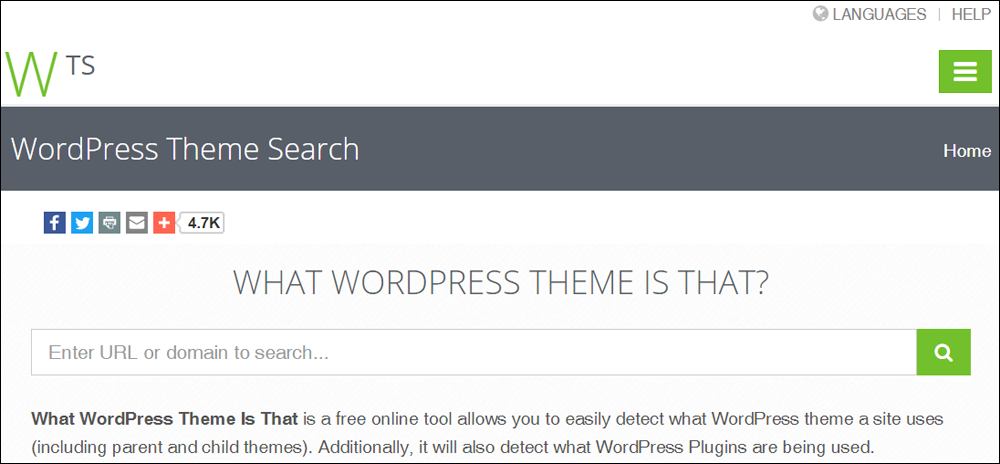
What WordPress Theme Is That is a free online theme and plugin search tool that lets you easily detect what WordPress theme and plugins a site is using (including parent and child themes).
This is a great resource if you ever come across a WordPress site and would like to know what WordPress theme (and plugins) the site uses.
Using this tool is quite simple. Just enter the site’s domain name into the field and click the search icon or hit “Enter.”
The tool will not only confirm if the site is powered by WordPress, but it will also list the WordPress theme (and detect all the plugins) used on the site.
![]()
Tip: If you can’t tell if a site was built using WordPress, see this tutorial: How To Tell If A Site Was Built Using WordPress
WPThemeDetector

WP Theme Detector is another tool that detects which WordPress theme and plugins are being used on a site.
To experience the magic of WPTD, just enter the URL of a website into the ‘Site to Check’ field and click the button.
Theme Check

If you have any concerns about a WordPress theme that you have installed on your site, you can use a free WordPress plugin like Theme Check to scan your theme files.
This plugin was developed by the team that checks all themes submitted to the WordPress Theme Directory.
It runs the same automated testing tools on your theme that WordPress.org uses for theme submissions and lets you know if it detects any errors in the theme files.
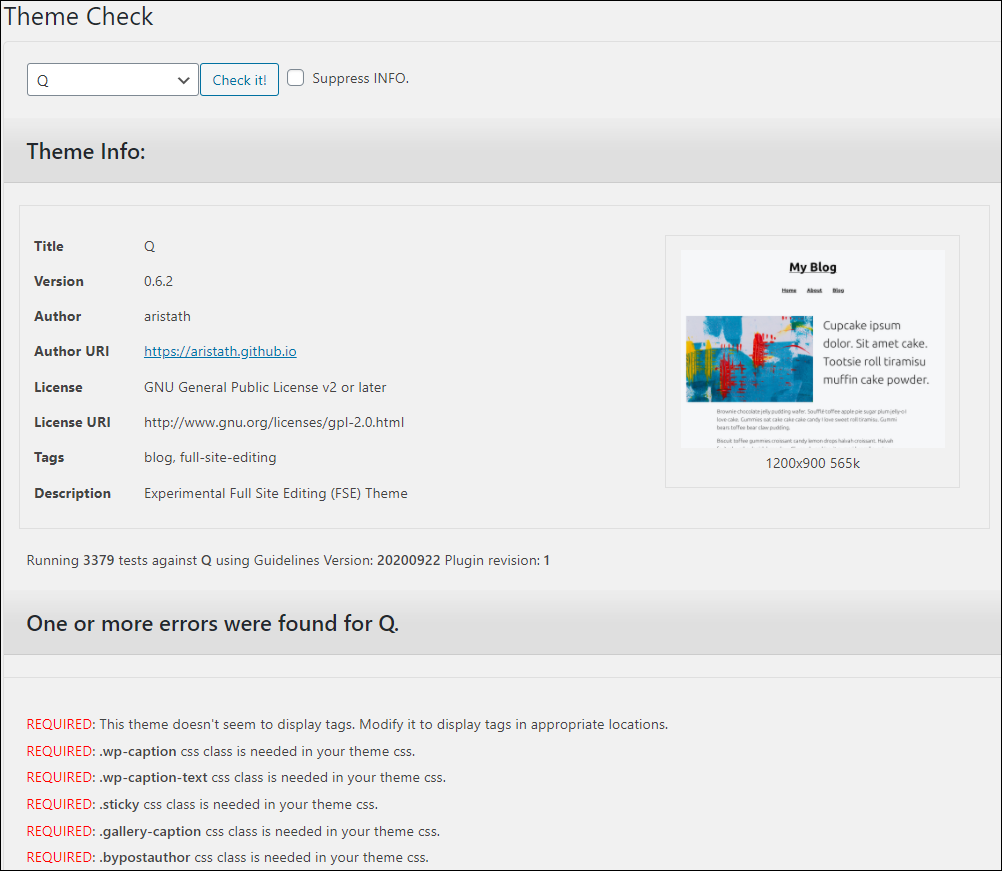
We recommend only downloading and installing free themes on your site that pass all the basic tests.

![]()
We suggested this earlier and it’s worth repeating it: If you decide to use free themes for your WordPress site, we recommend sticking with the reviewed and approved themes listed in the official WordPress theme repository.
A method that is commonly used by hackers and cybercriminals to inject malware into websites is to put up fake sites and directories offering “Free” WordPress themes and then distribute modified themes containing malicious code through these sites.
Some of these sites even display on Google’s search results for key phrases like “free WordPress themes“, “best free themes for WordPress” etc. It’s safer, therefore, to stick with free themes from the official WordPress.org theme directory, or use established and trustworthy theme vendors.
Finding WordPress Themes – FAQs
Here are frequently asked questions about finding WordPress themes:
Where can I find WordPress themes?
You can find WordPress themes on various platforms, including the official WordPress.org theme repository, third-party theme marketplaces like ThemeForest, and directly from theme developers’ websites.
What factors should I consider when choosing a WordPress theme?
Consider factors such as design, customization options, responsiveness, speed, SEO-friendliness, compatibility with plugins, support, and regular updates when choosing a WordPress theme.
How do I know if a WordPress theme is responsive?
You can test a WordPress theme’s responsiveness by resizing your browser window or using online tools like Google’s Mobile-Friendly Test (Lighthouse). Responsive themes adjust their layout and elements to ensure a consistent user experience across various devices.
What are the benefits of using a responsive WordPress theme?
Responsive WordPress themes provide an optimal viewing experience for users on different devices, improve SEO rankings, increase mobile traffic, and enhance user engagement and satisfaction.
Can I customize a responsive WordPress theme?
Yes, you can customize a responsive WordPress theme just like any other WordPress theme. You can modify its appearance, layout, colors, fonts, and more to suit your website’s needs.
Are all WordPress themes responsive by default?
No, not all WordPress themes are responsive by default. It’s essential to choose a theme that explicitly mentions its responsiveness or has been tested for responsiveness to ensure compatibility with various devices.
How can I find a responsive WordPress theme?
Look for themes labeled as “responsive” in their descriptions or search for responsive themes on reputable theme marketplaces. You can also filter themes by responsiveness on some theme directories.
What should I do if my chosen WordPress theme isn’t responsive?
If your chosen WordPress theme isn’t responsive, you may need to consider switching to a responsive theme or hiring a developer to make the necessary adjustments to ensure mobile-friendliness.
***
We hope that you have found this information on finding free and paid WordPress themes useful.
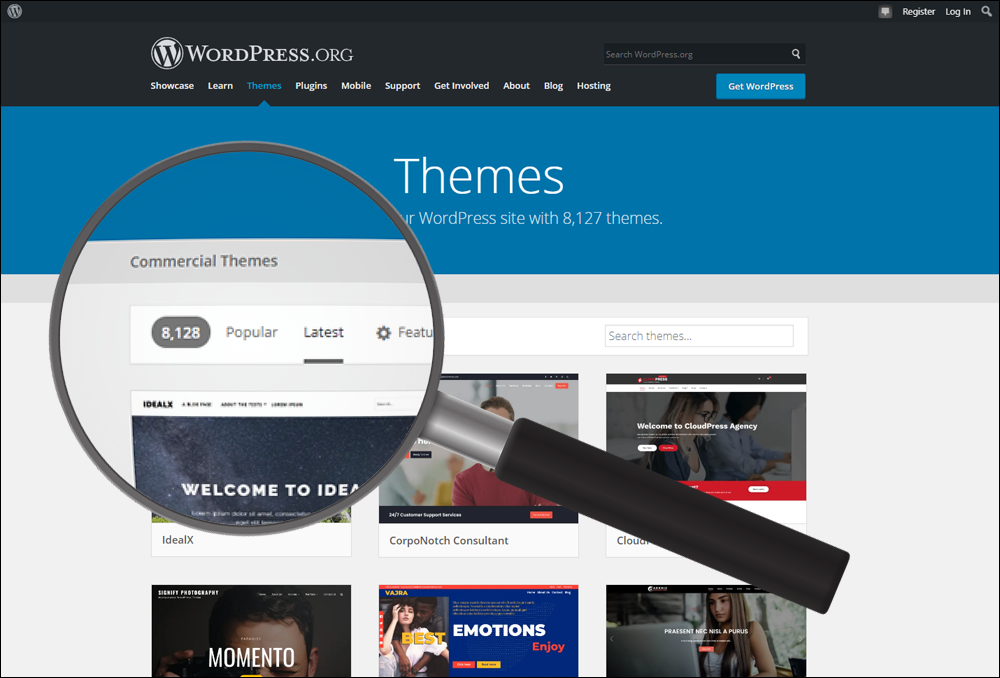
For additional information on using WordPress themes, see the tutorials below:
- How To Tell If A Site Was Built Using WordPress
- WordPress Themes Explained
- How To Install WordPress Themes From Your WordPress Dashboard
- How To Install WordPress Themes Manually
- How To Update WordPress Themes
- How To Use The WordPress Theme Customizer
***
Updated: July 5th, 2024
